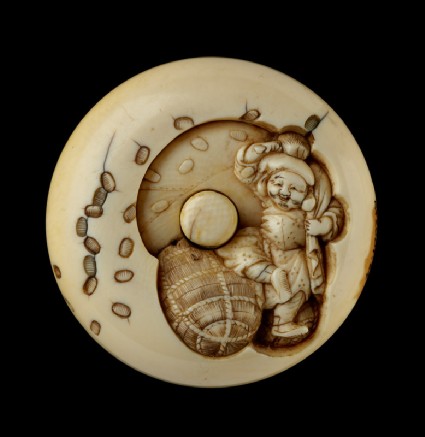Browse: 1141 objects
- Reference URL
Actions
Manjū netsuke depicting Daikoku scattering coins for Ebisu
-
Description
The god Daikoku scattering coins from his magic mallet for the god Ebisu to catch in his fish basket.
-
Details
- Associated place
- Date
- late 19th century
- Artist/maker
-
Shunkōsai Chōgetsu (1826 - 1892)
- Material and technique
- ivory, probably lathe-turned, with shishiaibori (sunken relief carving), and stained with pigment
- Dimensions
-
2 cm (height)
5.1 cm (diameter)
- Material index
-
organic › animal › tooth › mammal tooth › ivory
- Technique index
- Object type index
- No. of items
- 2
- Credit line
- Bequeathed by Dr Monica Barnett, 2001.
- Accession no.
- EA2001.64
-
Further reading
Oxford: Ashmolean Museum, 23 April-22 September 2013, Manjū: Netsuke from the Collection of the Ashmolean Museum, Joyce Seaman, ed. (Oxford: Ashmolean Museum, 2013), no. 39 on p. 106, illus. p. 107
Glossary (2)
Manjū, netsuke
-
Manjū
The manjū is a type of netsuke or toggle which takes its name from a round, sweet, bean paste-filled bun. A greater dynamism can often be achieved on the front and back of the netsuke than with other three-dimensional carving.
-
netsuke
The netsuke is a form of toggle that was used to secure personal items suspended on cords from the kimono sash. These items included purses, medicine cases or tobacco paraphernalia.
Past Exhibition
see (1)-

Tales in the Round: Manjū Netsuke and Japanese Woodblock Prints
(from 30th Apr until 22nd Sep 2013)
Location
-
- currently in research collection
Objects are sometimes moved to a different location. Our object location data is usually updated on a monthly basis. Contact the Jameel Study Centre if you are planning to visit the museum to see a particular object on display, or would like to arrange an appointment to see an object in our reserve collections.
© 2013 University of Oxford - Ashmolean Museum



